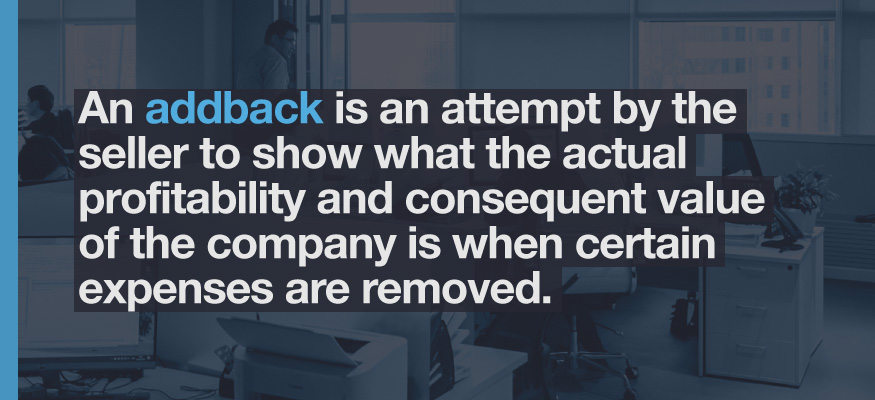- Why EBITDA is a sub-standard metric for determining the health of a business
- Why free cash flow is so important
- How to calculate free cash flow and what your true earnings would be as a business owner
If you’ve spent even half an hour looking for businesses to acquire, you know that their prices are usually determined as a multiple of EBITDA.
EBITDA (earnings before interest, taxes, depreciation, and amortization) is a common metric used to compare profitability between companies and industries, but it does very little to explain how much money you, as the owner, will have in your pocket at the end of the month.
What the hell is the point of EBITDA when most business owners simply want to know how much money they’ll be taking home at the end of each month?
Traditionally, cash flow, net income, and revenues have been used as metrics to evaluate a company's financial health and value. But over the years, EBITDA has crept its way into balance sheets like the Real Housewives of just about any urban center has crept into the public consciousness.
While EBITDA has its place–much like a guilty pleasure–it’s not always an accurate depiction of how well a company is doing.
At Acquira, we prefer to look at your pro-forma free cash flow.
What Is Free Cash Flow?
Free cash flow (FCF) is the cash that remains after a business has paid for everything it needs in order to operate, including any capital expenditures (such as property and equipment).
Basically, once you know what your free cash flow is, you know exactly how much cash you’ll be able to put into your pocket.
It’s also a handy metric to help guide key business decisions, such as whether to expand the company or invest in ways that might reduce operating costs.
Investment advisor and hedge fund manager Phil Town explains the concept rather well:
Investors and buyers can also use the free cash flow equation to check for accounting fraud, given that these numbers are harder to manipulate than things like net income or earnings per share.
In traditional investing, shareholders will use FCF to give them an idea of how much money might be distributed in dividend payments or share buybacks. For Acquisition Entrepreneurs, the number is a good indicator of what you can expect to put in the bank at the end of each month.
Why Is Free Cash Flow Important?

When we acquire businesses, we know that we’ll be incurring some growth-related expenses. After all, we want to build up and expand these businesses as much as possible. And the age-old saying still applies: “you have to spend money to make money.”
So, if we can determine how much money will be left over at the end of each month, we’ll know how much there is to spend on growth.
It also tells us how big the business needs to be in order to hit our own personal cash flow targets.
Knowing how much the business is making can give you an idea of how much profit you’ll make each month. But knowing how much the business is spending will help you calculate, with reasonable certainty, how much money you’ll actually have left in your pocket at the end of the day.
Pay Close Attention To Addbacks
Addbacks are business expenses on the financial statement that the seller says will essentially “go away” when the business is sold, and the buyer takes possession.

In that way, it’s an attempt by the seller to show what the actual profitability and consequent value of the company is when certain expenses are removed. In the eyes of the seller, those expenses are either not “real” company expenses or are related to the current owner and will not transfer to the buyer. Or they were one-time expenses that the new owner would not incur.
For example, if the previous owner was fond of making certain charitable donations, they will likely argue that this wouldn’t be a cost of doing business, thus it would be added back to the earnings of the business.
But if you accept an addback from the seller, it means these expenses will not be included in your free cash flow calculation after you buy the business, and sometimes these expenses turn out to be necessary.
When you’re in the midst of an acquisition, you need to go through each revenue and expense item and ask yourself a few key questions:
- Is this revenue going to continue into the coming years?
- Why would it not continue?
- Is it an addback? If so, is the addback actually necessary?
If the seller insists that a certain cost isn’t necessary for the business, you should investigate more thoroughly. A regular donation may seem like an expense that can be cut, but it could actually be necessary for maintaining a good relationship with a union. Or it may be an ongoing donation to a local church that gives the business a lot of work.
Likewise, it might seem like the business continually reports exorbitant meal expenses, which the seller may declare an addback. But in actual fact, it could be that they have an agreement with their employees to buy lunch every day. In that case, lunches are an employee perk and should be considered a true cost of doing business.
These are issues that may not be obvious to the buyer until after the fact, and so warrant further investigation. While they may not appear to impact the calculation for free cash flow, they could actually be an integral part of the cost of doing business.
Unacceptable addbacks
There are a number of expenses that at first blush might appear to be addbacks, but actually shouldn’t be considered as such. Because of this, they can be included in the free cash flow calculation. Here are a few:
| Subcontracted Labor Costs | A company may choose to use a lean, full-time team and use subcontracted labor during seasonal periods, which is perfectly reasonable. However, the costs of these subcontractors should not be considered an addback. |
| Marketing Expenses | A company may say that a poor marketing campaign or sales promotion was a one-off expense and should be added back. However, marketing and advertising are part of everyday business procedures and should not be added back. |
| Annual expenses that look like “One-Time” Expenses | Some expenses can look like they are one-offs like repainting the office or building repairs. Even though these expenses do not come up every month there are actually recurring, given that they need to be repeated at regular intervals. |
| Research & Development Expenses | Companies seeking to grow must engage in ongoing investment, including R&D. By its nature, this is ongoing so it cannot be added back. |
| Retroactive Change Benefit | The buyer may want to add back future savings from changes in the business (ie: swapping service providers or buying cheaper inputs). But if the company has yet to make these changes they cannot add these back. |
Look At Large Capital Expenses
Before buying a business, you should also look at any large capital expenses that are necessary. This will deeply impact how you compute free cash flow for a company.
Take a look at all of the heavy machinery: trucks, cars, and other specialized equipment. Look at how old the equipment is and the overall mileage on each machine. Will it need to be replaced? If something breaks, do you have a backup? In either case, buying new vehicles will be a heavy but necessary capital expense that will change how much money is left at the end of the month.
When new owner Hayden arrived at the offices of an HVAC business we recently acquired in the Southcentral United States, he instantly saw a problem.
“The office had not changed in 35 years when the company had five employees,” he explains. “They grew to 35 employees and it was the same office.”
The previous owner Mike works from his office while three other people work in a second small room. While a serviceable setup, the cramped quarters caused an organizational headache each morning when technicians would arrive to get their marching orders for the day. Between 7 AM and 9 AM people would mill about, trying to get face time with the owner or the dispatcher.
“It's f**king hectic, it's crazy,” explained Hayden.
The first solution was to get another office manager to help deal with the workload and organization. However, Hayden knew that the simplest solution was to just give everyone more space.
“So I've literally decided that we can build another office because we need another space,” he said. “They had this large truck covering that fit three trucks. And instead of just putting them there we'll lock them up in the yard and leave them outside. We've started converting that into a much larger office space with a little conference room.”
The new space will allow management to present information to all of the crews in a comfortable setting, rather than huddled in a drafty warehouse as had been done in the past.
The cost of building a new office is a large, one-time capital expense. And while it can be amortized over multiple years, it will still impact how much money is left over for the owner to take home each month.
There are other capital expenses you may want to consider. For instance, your salespeople may need cars. You might want to provide them with cell phones or tablets to increase their efficiency.
Whatever the case may be, new capital expenses will have a deep impact on your future free cash flow.
Adding New Expenses

As we said earlier, if you want to make money, you’ve got to spend money. And if you want to grow a business, that means adding new expenses–expenses that can greatly impact your free cash flow calculations.
For instance, most of the home services businesses we acquire will implement a software tool like ServiceTitan to help coordinate their staff in the office and in the field and further systematize the business. That adds a cost of $250 per employee per month. Depending on how many employees a company has, that really adds up over a year.
Each of these companies will likely need to implement an online marketing campaign as well. Many home services businesses are old school, and some lack any sort of online presence at all. An effective SEO campaign can help a company raise its profile and attract new business, but it’s going to cost money, often between $3k and $5k per month.
One of the first things that any buyer should do is sit down with the seller and create an organizational chart. The chart will help you familiarize yourself with the workings of the company, but it will also reveal any holes in your payroll.
You might find that one person is taking on too many roles or that someone is close to retirement and there’s no one who can replace them. In these instances, you’ll need to hire someone new. You’ll likely hire a new general manager as well. Each of these will incur long-term, ongoing costs that impact your free cash flow.
Consistent Cash Flow and Seasonality
The goal in calculating each of a business’ expenses and sources of revenue is to come up with a plan for creating consistent cash flow.
The goal in calculating each of a business’s expenses and sources of revenue is to come up with a plan for creating consistent cash flow.
More than a few home services businesses have a season where business slows down (in the industry, this is called a shoulder season). So a new owner should take into account any seasonality in the industry.
In the off-season, you’re still going to need to make sure there’s work for all of your employees. Or maybe you’ll have to furlough some workers. Either way, knowing that in advance will help alleviate future stress.
You should make sure that whatever money is coming in, you’re putting enough in the bank to distribute to yourself during the off-season. Just because you can take home $80,000 in June doesn’t mean you should.
What Is the Formula for Calculating Free Cash Flow?
The formula to calculate free cash flow is:
Free Cash Flow = Operating Cash Flow - Capital Expenditures
If the company you’re looking at hasn’t disclosed capital expenditures or operating cash flow, there are other equations that will help you figure out the same information. Including:
Free Cash Flow = Sales Revenue - (Operating Costs + Taxes) - Required Investments in Operating Capital
Free Cash Flow = Net Operating Profit After Taxes - Net Investment in Operating Capital
In many ways, though, those are overly simplistic explanations for what can often be a complicated process, as witnessed by the points made above. To truly determine what the FCF is for a business, you need to spend time digging through its financials and pursue any questions you have with the seller.
Of course, for Acquira partners, we have created a Free Cash Flow Calculator that you can use to help determine how much money you’ll actually put in your pocket after you buy a particular business. It’s one of the resources our partners have access to after completing our Acceleration Gauntlet.
Conclusion
As a metric for a business’ health, free cash flow isn’t without its limitations. After all, a low free cash flow may not indicate a failing business. Healthy companies often see a decline in FCF when they’re actively working toward growth. Acquisitions and investments like those mentioned above can cause temporary declines in your bottom line.
By using the methods above, you should be able to look deeper into the numbers to see if a company is actually sustainable and worthy of investment. This process should help you take calculated risks to close the perfect acquisition deal.
At the end of the day though, most owners want to know that their family will be taken care of, that their workers will be supported, and that the business will continue to grow. In that case, the free cash flow formula is an excellent tool.
Have you had any difficulty determining the free cash flow of a company? Let us know in the comments below. And if you know anyone in the midst of analyzing a business’ health, please share this article with them.
Meanwhile, if you haven’t signed up for our Acceleration Gauntlet yet, now is a great time to start your business-buying journey with Acquira. If you’d like more information, schedule a call with us today.
Key Takeaways
- Free cash flow can show you how much you will take home at the end of each month.
- Look beyond the information the seller provides to see if there are any additional ongoing costs that aren’t being taken into account.
- Take a look at the company’s vehicles and heavy machinery. Does any of it need to be replaced?
- Determine whether you will need to incur any other ongoing capital expenses to grow the business.
Acquira specializes in seamless business succession and acquisition. We guide entrepreneurs in acquiring businesses and investing in their growth and success. Our focus is on creating a lasting, positive impact for owners, employees, and the community through each transition.



